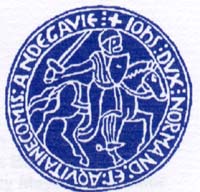
The Magna Carta Trust
|
Magna Carta in Modern Times
Why is Magna Carta important today?
Magna Carta was an attempt in 1215 to codify the relationships between the three great power blocks in the land, the King and his state apparatus, the Church led by the Pope, and the Barons with their castles and great estates. It was at first a short lived peace treaty after a period of civil war, forced upon the King by the Barons. A detailed history of this period is to be found at the heading St Edmundsbury and Magna Carta.
In 1996, the Lord Chief Justice, Lord Bingham wrote, "Historically, the constitutional significance of Magna Carta has depended much less on what the charter said, than on what it was thought to have said. What it was thought to have said was the subject of constant development, with the aid of some statutory reinforcement, over succeeding centuries. It was this process which led to the English Bill of Rights, the heavy reliance placed on Magna Carta by the American colonies in their battles against the crown, the constitution of the United States and, more recently, the constitution of the Republic of India."
Some of this process is detailed below, as used by the 17th century reformers.
| 1628 |
Sir Edward Coke introduced his bill of liberties in the House of Commons, referring to "Magna Carta is such a fellow, that he will have no sovereign." The bill led to the Petition of Rights. |
| 1679 |
The Habeas Corpus Act looked directly back to Clause 39 of the Charter. "No free man shall be seized or imprisoned, or stripped of his rights or possessions or outlawed or exiled or deprived of his standing in any other way, nor will we proceed with force against him, or send others to do so, except by the lawful judgement of his equals or by the law of the land." |
What does the Magna Carta mean for St Edmundsbury?
| 1835 |
The Municipal Corporations Act introduced some elements of democracy into local government and the old self-appointed corporation was abolished in Bury St Edmunds and replaced by a Council elected by the town's ratepayers.
|
|
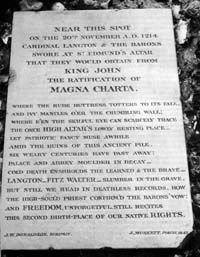
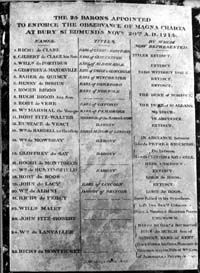
Click on tablets to see larger image
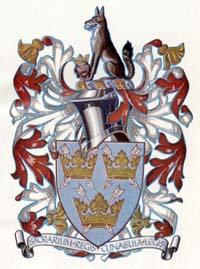 |
| 1847 |
By the 1840's, the new Council had established itself and in common with the rest of Victorian England there was an explosion in local civic pride. There was a growth in the idea of self-improvement and a thirst for knowledge about history, botany, and antiquarianism in its widest sense.
The town erected two stone tablets among the remains of the old abbey church commemorating the Barons' meeting here in 1214. One of these stated that Archbishop Langton was there, and includes a poem which refers grandly to the spot as "This second birthplace of our native rights". The other stone contains a list of names of the Barons who, it was supposed at the time, assembled here in 1214. |
| 1850 |
The idea now grew up that the town should capitalise on these ancient connections.
The Mechanics Literary and Scientific Institution held a lecture in Bury St Edmunds on 17th December, addressed by John Greene, founder of the Bury firm of solicitors, Greene and Greene.
His address included the following:
"We ourselves ought not to be insensible of the honour which is due to our town as the theatre of this illustrious event. Rival cities have contended for the honour of being the birthplace of Homer and the nursery of Tasso; pilgrimages are made to the house in which Shakespeare was born. --- And have not we reason to be proud - shall not we proclaim the notable distinction - that here was initiated a germ of the glorious destiny of our country; here was laid the foundation of a monument more loved, more renowned, more lasting than our abbey? Bury St Edmunds was the deliberately chosen ... rendezvous of the barons; it was the centre and rallying point of the region which acknowledged their principles and shared their enterprise".
At about this time the town added a motto to its coat of arms, 'Sacrarium Regis, Cunabula legis' or Shrine of a King, Cradle of the Law.
A hundred years later, Magna Carta still excited admiration, and the Magna Carta Trust was formed. |
What is the Magna Carta Trust?
| 1957 |
The Magna Carta Trust was formed under the patronage of distinguished leaders of Church and State, including archbishops, the Lord Chancellor, the Speaker of the House of Commons, high commissioners of many commonwealth countries, the American Ambassador in London and the Chairman of the Executive Committee of the National Trust.
The Chairman is the Master of the Rolls, the Trustees are the Chairmen of the Pilgrims of Great Britain, the English Speaking Union, and the Joint Commonwealth Societies Conference, the President of the Law Society, the Lord Mayor of London and the Mayors of St Albans, Canterbury and Bury St Edmunds, and the Chairman of Egham UDC. (In 1974 the local authority representatives were to change). American trustees are the President and Treasurer of the American Bar Association and the Marshall of the Baronial Order of Magna Carta.
The objects of the Magna Carta Trust are
- The perpetuation of the principles of Magna Carta;
- The preservation for reverent public use of sites associated with Magna Carta;
- The Commemoration triennially, and on such occasions as shall be determined by the Trust, of the grant of Magna Carta as the source of the constitutional liberties of all English-speaking peoples and a common bond of peace between them.
In Autumn 1957 the American Bar Association erected a memorial to Magna Carta at Runnymede under the auspices of the Trust. |
|
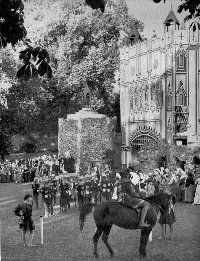
Scene from the 1959 Pageant |
| 1959 |
In June 1959, the first of the triennial commemorations was held in the Abbey Gardens, in Bury, with a ten day Pageant of Magna Carta. Hundreds of people took part and many thousands came to see the performances. Celebrations were to rotate between the 5 Charter Towns, every three years, as follows:
Bury St Edmunds
Canterbury
City of London
St Albans
Runnymede
|
| 1974 |
With local government reorganisation came a change in the participating local authorities. They now became The Mayor of the City of St Albans, The Lord Mayor of the City of Canterbury, The Mayor of the Borough of St Edmundsbury (Bury St Edmunds) and the Mayor of the Borough of Runnymede (previously Egham UDC). |
| 1996 |
The Magna Carta Trust was notified of a proposal by the Australia-Britain Society to erect a Magna Carta memorial in Australia's national capital by the old Parliament House in Canberra adjacent to Langton Crescent. Its motto would be "Freedom under Law". |
| 1998 |
The latest triennial celebrations were held at St Albans in June as usual. |
| 2001 |
The next Magna Carta celebrations are due to be held at Runnymede. |
| 2004 |
In June 2004, it will be time for Bury St Edmunds to once again host the Magna Carta Trust's celebrations, an event which rotates between the five Charter towns every 3 years, therefore taking 15 years to re-visit each town. It will be 45 years since the first such celebrations, the Bury Pageant of 1959. |
Prepared for the St Edmundsbury
Website by David Addy
August 1998
|




